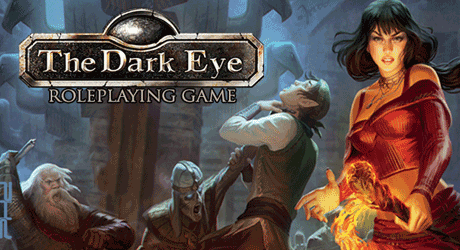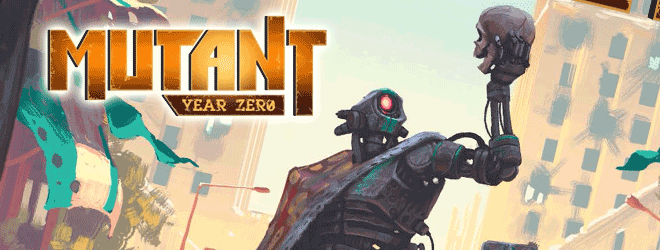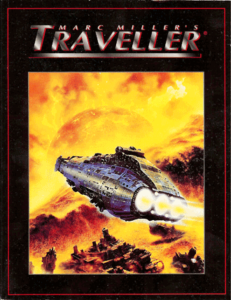 In May 2024 we revived the September 2019 Traveller4 Bundle featuring the 1996 Fourth Edition of the classic Traveller SFRPG.
In May 2024 we revived the September 2019 Traveller4 Bundle featuring the 1996 Fourth Edition of the classic Traveller SFRPG.
In Designers & Dragons: The ’90s, Shannon Appelcline recounts the story behind T4. After Traveller‘s original publisher, GDW, shut down in January 1996, rights to Traveller reverted to designer Marc W. Miller. Marc licensed the game to Imperium Games, the fourth of 21 short-lived companies started by longtime industry inhabitant Ken Whitman. Financed by Courtney Solomon‘s company Sweetpea Entertainment, Whitman lured GDW staffers Lester Smith and Timothy Brown, along with other Traveller stalwarts, to prepare a new edition.
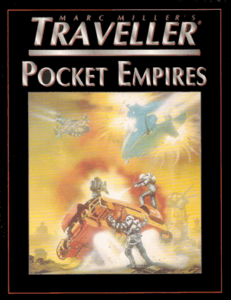 GDW’s MegaTraveller and Traveller: The New Era had transformed the rules and destroyed the Third Imperium interstellar empire, but the new edition, it was said, would restore the spirit of Classic Traveller and explore the Imperium’s earliest days, “Milieu 0.” In the event, the Traveller4 rulebook, written by diverse hands in just four months, proved a mess: sloppy editing, indifferent artwork and layout, and rules systems that each worked well enough on their own but combined oddly. For instance: (1) Traveller4‘s character generation system and skill list are perhaps the best in the game’s long history; (2) the combat system (once you incorporate its extensive errata) works smoothly, with fine-grained difficulty ratings and a simple penetration-damage scheme adapted from Striker and MegaTraveller; but (3) the characters you made in (1) can easily achieve skill ratings that steamroll any difficulties they meet in (2).
GDW’s MegaTraveller and Traveller: The New Era had transformed the rules and destroyed the Third Imperium interstellar empire, but the new edition, it was said, would restore the spirit of Classic Traveller and explore the Imperium’s earliest days, “Milieu 0.” In the event, the Traveller4 rulebook, written by diverse hands in just four months, proved a mess: sloppy editing, indifferent artwork and layout, and rules systems that each worked well enough on their own but combined oddly. For instance: (1) Traveller4‘s character generation system and skill list are perhaps the best in the game’s long history; (2) the combat system (once you incorporate its extensive errata) works smoothly, with fine-grained difficulty ratings and a simple penetration-damage scheme adapted from Striker and MegaTraveller; but (3) the characters you made in (1) can easily achieve skill ratings that steamroll any difficulties they meet in (2).
In 1997 Imperium Games followed the T4 rulebook with 14 support titles of strikingly uneven quality. (Some of the most interesting books were created by an outside studio, the CORE Group, and by Greg Porter of BTRC, whose EABA game line we’ve presented twice) In 1998 Imperium vanished as quickly as it had arrived. Two years later Solomon produced and directed the first Dungeons & Dragons film. As for Whitman’s later career, a search for “Ken Whitman Traveller” brings many results.
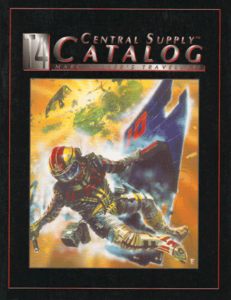 Though Traveller4 never found a large following, it still has fans. Its setting, the young Third Imperium spreading from Core Sector to recover thousands of lost worlds, is unique in Traveller‘s long history. Despite their poor editing, which spawned 30 pages of consolidated errata, the T4 books present many good ideas and system-neutral setting descriptions that work well with any Traveller milieu. This revived September 2019 Traveller4 Bundle once again presented the T4 rulebook and the best supplements and adventures – everything you need to venture out in your scout ship (or your battle squadron) to recontact the Pocket Empires lost in the Long Night. And yes, we included the errata.
Though Traveller4 never found a large following, it still has fans. Its setting, the young Third Imperium spreading from Core Sector to recover thousands of lost worlds, is unique in Traveller‘s long history. Despite their poor editing, which spawned 30 pages of consolidated errata, the T4 books present many good ideas and system-neutral setting descriptions that work well with any Traveller milieu. This revived September 2019 Traveller4 Bundle once again presented the T4 rulebook and the best supplements and adventures – everything you need to venture out in your scout ship (or your battle squadron) to recontact the Pocket Empires lost in the Long Night. And yes, we included the errata.
Once again there were six titles in this revived offer’s Starter Collection (retail value $70) as DRM-free .PDF ebooks, including the complete T4 Marc Miller’s Traveller corebook (plus the Traveller4 Game Screen, along with the Traveller4 versions of the Central Supply Catalog, the ship-design system Fire, Fusion, & Steel (in its revised T4 version) and the Naval Architect’s Manual for interior ship design, and Milieu 0, a setting guide that describes the brave new Third Imperium, a thousand years before Classic Traveller.
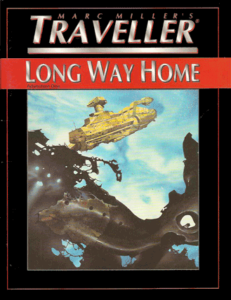 Those who paid more than the threshold (average) price also got this revival’s entire Bonus Collection with seven more supplements and adventures worth an additional $70, including the weapons guide Emperor’s Arsenal, Pocket Empires, the fleet action supplement Imperial Squadrons, Psionic Institutes, the two-part adventure Long Way Home and Gateway, and the nine-scenario collection Anomalies.
Those who paid more than the threshold (average) price also got this revival’s entire Bonus Collection with seven more supplements and adventures worth an additional $70, including the weapons guide Emperor’s Arsenal, Pocket Empires, the fleet action supplement Imperial Squadrons, Psionic Institutes, the two-part adventure Long Way Home and Gateway, and the nine-scenario collection Anomalies.
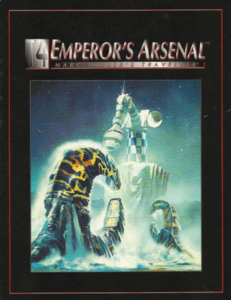 These .PDFs are decent image scans of the original 1990s hardcopies. Text is always clear and usually copiable, though a few books have background graphics that interfered with the OCR (optical character recognition). Illustrations are generally dark and muddy.
These .PDFs are decent image scans of the original 1990s hardcopies. Text is always clear and usually copiable, though a few books have background graphics that interfered with the OCR (optical character recognition). Illustrations are generally dark and muddy.
Ten percent of each payment (after gateway fees) goes to this Traveller4 revival’s designated charity, Direct Relief. Direct Relief sends protective gear and critical care medications to health workers, with emergency deliveries to medical facilities across the US and to regional response agencies across the world.

